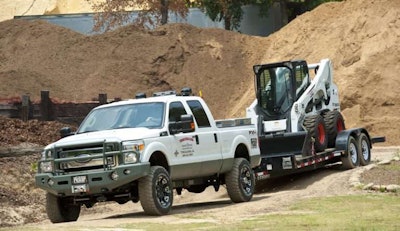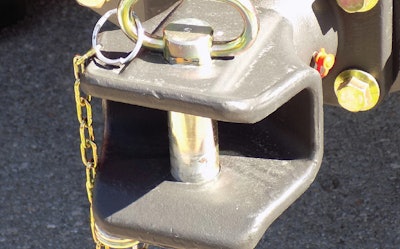
Take a look at recommendations from the Association for the Work Truck Industry (NTEA) to help improve your vehicle’s efficiency, safety and performance while towing a trailer.
Common mistakes
According to the NTEA, there’s a common belief among many trailer users that if a truck is still able to move, it’s not considered overloaded, which can cause problems for fleet operations.
Chris Lyon, NTEA director of fleet relations, says before towing, it’s important to know both your towing vehicle and trailer capabilities to ensure you fully understand how much payload is available for towing.
“Knowing your limiting factors will help your company determine how much can actually be legally towed with a specific vehicle-trailer combination and help maximize operating life of the equipment,” says Lyon.
Lyon says key componentry like safety chains, the pintle hook, the trailer hitch, the hitch ball, the receiver tube and more could be the ultimate limiting factor in the maximum towing capability of the tow vehicle and trailer combination.
Lyon says some of the most common trailer mistakes often include simple items like pre-trip inspections. While these inspections are mandatory for CDL class vehicles and trailers, he recommends performing a pre-trip inspection on all vehicles.
He also recommends checking that all signaling lights, markers and brake lights are functioning, and says to check that trailer brakes, if equipped, are functioning and calibrated.
Another common error Lyon has seen many times is overloading.
“The tow vehicle and trailer should be a designed solution to meet the appropriate capacities,” says Lyon. “Overloading can reduce operating life of the tow vehicle and trailer, and place the company, operator and other motorists at risk if the combination exceeds the payload for legal operation.”
There are several red flags to watch for that will signify that your trailer is overloaded, but one of the most obvious is vehicle handling. When there’s too much tongue weight, Lyon says this can cause steering issues, and tow vehicle weight distribution may become rear-heavy and front-light.
Along with this, Lyon says braking distances are greatly increased, and engine and transmission temperatures will increase beyond their normal operating parameters.
Training for this driving style
While it’s true that the trailer, attachment and towing vehicle all play a part in proper towing safety, it ultimately comes down to how prepared the operator is to drive in this situation.
Beyond knowing the correct procedures for loading and load securement, having experience driving with a towed trailer will require skills not normally exercised while driving without a trailer.
 Photo: NTEA
Photo: NTEA“The most important thing a driver can do to ensure safe and efficient towing vehicle trailer operation is to evolve driving style and attitude to accommodate for some element (or combination thereof) of the vehicle being driven,” the NTEA says online. “For example, the trailer is behind the primary vehicle, so the driver must adjust for scenarios such as changing lanes. This will ensure enough room for safe clearance. Awareness training when towing is essential for safe trailering operations.”
Training for this type of driving may sound difficult initially, but the NTEA says once drivers are able to successfully account for the overall differences in vehicle size, length and other specifics for that situation, the skills will become second nature.
Shopping specs
When shopping for a trailer, Lyon says to start your process by defining what will be trailered, design the trailer and then identify the tow vehicle.
In his experience, Lyon says many tow vehicles are purchased before towing needs are identified, which often leads to the vehicle being undersized. This, he says, makes them limited on what they can tow and more likely to be overloaded.
He adds that oversized tow vehicles are less of an issue but will also carry additional expense when it comes to acquisition, fuels costs and maintenance.
When calculating the vehicle center of gravity and axle weight, Lyon says you can always use the NTEA calculator or calculations can be done manually.
“When selecting a towing vehicle for an existing trailer, the end-user should request the truck dealer’s assistance in trailer weight considerations,” says Lyon. “Miscalculating too low can cause productivity loss or an overloaded and potentially hazardous trailer. Calculating too high may increase operating and maintenance costs.”
Lyon says it’s also important to choose the correct hitch for your trailer, and the necessary hitch type will depend on what you plan to tow. Lyon says some hitches may look similar but they are rated for different weight, including tow and tongue ratings.
“It’s important to understand trailer gross vehicle weight rating and ensure use of a hitch that meets or exceeds trailer maximum weight rating,” says Lyon.










